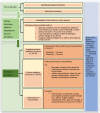The Future of Biomarkers in Veterinary Medicine: Emerging Approaches and Associated Challenges
- PMID: 36077913
- PMCID: PMC9454634
- DOI: 10.3390/ani12172194
The Future of Biomarkers in Veterinary Medicine: Emerging Approaches and Associated Challenges
Abstract
New biomarkers promise to transform veterinary practice through rapid diagnosis of diseases, effective monitoring of animal health and improved welfare and production efficiency. However, the road from biomarker discovery to translation is not always straightforward. This review focuses on molecular biomarkers under development in the veterinary field, introduces the emerging technological approaches transforming this space and the role of 'omics platforms in novel biomarker discovery. The vast majority of veterinary biomarkers are at preliminary stages of development and not yet ready to be deployed into clinical translation. Hence, we examine the major challenges encountered in the process of biomarker development from discovery, through validation and translation to clinical practice, including the hurdles specific to veterinary practice and to each of the 'omics platforms-transcriptomics, proteomics, lipidomics and metabolomics. Finally, recommendations are made for the planning and execution of biomarker studies with a view to assisting the success of novel biomarkers in reaching their full potential.
Keywords: biomarkers; genomics; lipidomics; metabolomics; proteomics; transcriptomics; veterinary.
Conflict of interest statement
The authors declare no conflict of interest.
Figures
References
-
- National Research Council (US) Committee on the National Needs for Research in Veterinary Science . Critical Needs for Research in Veterinary Science. National Academies Press; Washington, DC, USA: 2005. [(accessed on 27 July 2022)]. Available online: https://www.ncbi.nlm.nih.gov/books/NBK22917/ - PubMed
-
- Soetan K., Abatan M. Biotechnology a key tool to breakthrough in medical and veterinary research. Biotechnol. Mol. Biol. Rev. 2008;3:88–94.
Publication types
LinkOut - more resources
Full Text Sources


